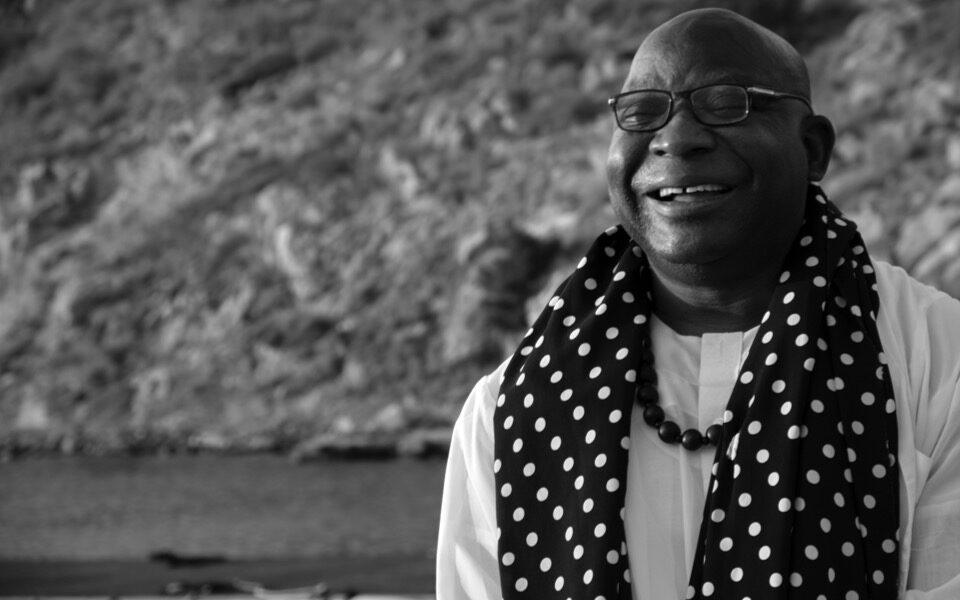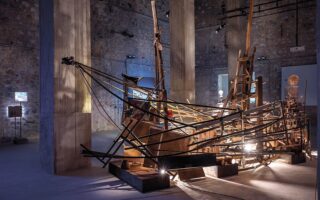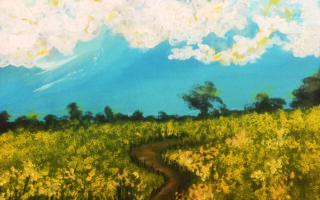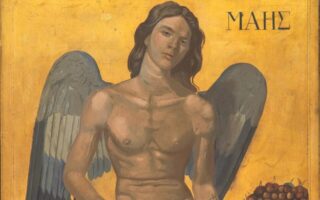Celebrating the richness of life in Hydra: Barthelemy Toguo and ‘Life Is a Dream’

Renowned “artivist” Barthelemy Toguo shared insights into his creative journey and the philosophy behind his work as he closed the six-week art exhibition “Life Is a Dream” on the Saronic island of Hydra at the beginning of this month. The show was born from the collaboration between Wilhelmina’s Art Gallery on Hydra and the Nosbaum Reding Gallery in Luxembourg and took place on Hydra. Whilst being a fairly new gallery, Wilhelmina’s has managed to establish itself in the art world, hosting exhibitions of contemporary works by celebrated international artists. The aforementioned show displayed works by Toguo, Damien Deroubaix and Manuel Ocampo.
Toguo, born in Cameroon in 1967, works between Paris, France and Bandjoun, Cameroon and his achievements are nothing short of prolific, both as an artist as well as a philanthropist, being named UNESCO Artist for Peace 2021, finalist for the Marcel Duchamp Prize 2016 and Knight of the Order of Art and Literature, to reference a few. Exhibited at the Tate Modern, MoMA, the Pompidou Center, the Parkview Museum, Studio Museum and numerous biennales, Toguo’s art is a reflection of life’s beauty, complexity and richness.
Aiming to guide viewers to “a therapeutic process towards self-fulfilment,” he discussed his inspirations, techniques, and the role of the artist in expressing universal human emotions. In his youth, Toguo discovered “the Old Masters: Titian, Rembrandt, Goya. Their images emerge in a dark universe where form appears as light and it was a visual rendering of beauty that fascinated me.” While inspired by these masters, Toguo “did not seek to copy them” and “very quickly found my own voice, and I worked hard, delving into unknown territory that further fed my desire to continue painting and drawing.”
‘My technique allows me to express beauty and violence at the same time; in short, a whole range of universal human feelings’
For Toguo, art is about evoking powerful feelings and capturing the essence of human experiences. “The most important thing for me is to be able to express emotions, sensations and human feelings. My technique allows me to express beauty and violence at the same time; in short, a whole range of universal human feelings. It permits the creation of light, sadness, darkness and beauty but what is most interesting is the universal dimension because regardless of where or who you are, you can experience all these emotions and all these sensations.”
One notable aspect of Toguo’s approach is his versatility in choosing materials. “What’s important for me is to find the material that will allow me to express what I want to achieve. If I think that wood or metal or ceramic will allow me to express my idea, I’ll use that without thinking.” This confidence and trust in both his vision as well as his materials was fostered through his extensive art studies. “I was lucky enough to study ceramics, engraving and sculpture at Abidjan, performance and installation at Grenoble, and then to hone a more professional expression of these techniques at the Kunstakademie in Dusseldorf.” “Today, I’m able to measure and decide what’s easiest for me to use to express an idea or a thought. If performance is the most effective way I’ll do the performance; if it’s painting, then painting will gain the upper hand.”
Still, he does not claim that all young artists must follow artistic studies in order to succeed. Yet his academic background “gave me this richness of choice and the ability to not hesitate between any techniques when deciding what needs to be done to express myself.”
One of Toguo’s remarkable projects is Bandjoun Station, a nonprofit organization that combines art, architecture and agriculture to benefit the local community. “It is an exhibition space for international and local artists with studios, and we also provide workshops. Local artisans built the center from my designs and plantations were created. Food is produced and given to the population. The aim is to achieve self-sufficiency artistically and nutritionally to have a direct impact on the immediate surrounding society.” Toguo aims to achieve self-sufficiency artistically and nutritionally, harvesting vegetables for the children. Moreover, this project serves an additional purpose by providing a direct platform to voice his opinions on particular issues. “In this way, I can address directly the problem of the exportation of contemporary art and artists from the African continent to Europe, America and Australia, but also the more immediate problem of self-sufficiency. People need the chance to see art, to learn what it is. But to do this we have to address the social concerns too. In a way, Bandjoun Station is an artwork like the other projects I spoke to you about.”
Toguo’s art is a celebration of life’s richness, a reflection of universal human emotions, and a bridge between cultures. His ability to express complex feelings and experiences through various mediums and techniques makes his work not only visually captivating but also emotionally resonant. Toguo’s dedication to his craft and commitment to using art as a tool for social change exemplifies the power of creativity to inspire and connect people across the globe.





